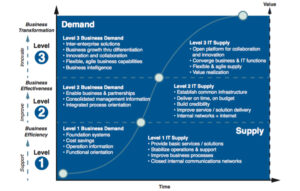The Business Provider Maturity Model
The Business Provider Maturity Model is a way to help surface and understand the growth in maturity of business demand for Provider services and capabilities, and a Provider organisation’s maturity of supply capabilities needed to both satisfy and shape that demand.
The Business Provider Maturity Model explained

The Business Provider Maturity Model
The Business Provider Maturity Model employs an S-shaped learning curve to represent the growth in business learning to exploit the Provider capabilities and assets and the Provider learning to become efficient and effective in delivering services and, especially as maturity increases, shaping business demand. Business executives often find the model’s simple elegance appealing. They quickly grasp the concepts behind business demand maturity and are able to use the model to analyse how their demand maturity is evolving over time. This equips them to engage in meaningful dialogue with Provider leadership about the business implications of both demand and supply maturity.
Background
The Business Provider Maturity Model was originally developed in the early 1990s as the Business-IT Maturity Model (BITMM). It was developed by Vaughan Merlyn and a team of researchers he was leading at Ernst & Young’s Center for Business Innovation. The model came out of a 3-year longitudinal study of 35 global IT organisations that were in various stages of IT organisational transformation. Vaughan subsequently led other research teams at The Concours Group to further study and refine the BIMM, including the collection of detailed assessment data from about 100 global IT organisations. The model has also benefited from 20 years of practical application in the course of IT management consulting.
The research revealed that, while process management (the basis of CMMI) is a critical discipline, especially at low Business-IT maturity, reaching higher maturity requires sophistication with demand-side disciplines. For example, it is essential that strong business-IT relationships be forged and IT savvyness be developed among business executives and users, especially about the business value of IT and what it takes to realise that value.

For these reasons, the Business Provider Maturity Model addresses the maturity and trajectory of both business demand for the Provider’s services and/or products (the business’s appetite) and Provider supply (the ability to satisfy that demand) —two sides of the coin, as it were. In so doing, the model reveals patterns of inter- dependencies and disconnects between demand and supply over time. Demand and supply in many ways comprise an internal market, with reciprocal adjustments by both the business and the Provider organisation.
Purpose of the Business Provider Maturity Model
Maturity models are invaluable management tools. They can be applied to individuals, e.g. child to adolescent to adult; applied to organisations, e.g. start-up to growth to mature; and even to entire ecosystems, e.g. diffusion of innovation. Richard Nolan was among the first to propose a maturity model for IT management with his Stage Theory in the 1970s.
The Software Engineering Institute at Carnegie Mellon University contributed much to contemporary best practice in IT process improvement with a capability maturity approach known as Capability Maturity Model Integration (CMMI). Typically used in an inside out approach for assessing capability maturity and determining improvement practices, CMMI takes a firm position that process management is the key to IT improvement.
By contrast, the Business Provider Maturity Model is used both as a diagnostic—to surface the maturity of business demand for Provider services and capabilities and of Provider supply capabilities — and as a dialogic to drive dialog about business demand and Provider supply maturity and how these are evolving. The model can be used for an enterprise as a whole or for a given business unit or Provider capability unit.
Characteristics of the Business-Provider Maturity Model
In its simplest form, the model is an S-shaped learning curve—the business learning to exploit technology (or whatever services or products the Provider supplies) and the Provider organisation learning to become efficient and effective in delivering services and, especially as maturity increases, shaping business demand. Business executives often find the model’s simple elegance appealing. They quickly grasp the concepts behind business demand maturity and are able to use the model to analyse how their demand maturity is evolving over time. This equips them to engage in meaningful dialogue with Provider leadership about the business implications of both demand and supply maturity.
Figure 10 depicts the basic 3-level model. Note that the number of levels is arbitrary. It sometimes makes sense to use a 5-level model, which can be useful with its finer-grained approach, but the simplicity of the 3-level model works well for most purposes and avoids false precision.
Business Provider Maturity Model
To the left of the S-curve are the characteristics of business demand at each of 3 levels. To the right are the corresponding goals of Provider supply (in this case, IT). It is important to recognise this is a developmental model. As such, it is cumulative—the demand at lower levels never goes away—the business always wants the lights kept on, (a Level 1 demand). An IT organisation that fails to supply against this demand will lack credibility and wherewithal to move up the maturity curve. As business demand matures to Level 2, for example, Level 1 demand for efficiency does not go away—it becomes a fundamental expectation—table stakes.
- Level 1 business demand is typically generated from functional and geographic silos—often much to the frustration of IT leaders, who are able to look across the enterprise and see many opportunities for cross- functional processes and collaboration, but are unable to sell such concepts. Level 1 demand is primarily for foundational transaction processing solutions and operational data—all with an overarching goal of reducing the costs of doing business. Level 1 supply, in addition to satisfying business demand, focuses on the basic blocking and tackling of IT management—for example, project management and stable IT operations.
- Level 2 demand (which is additive to Level 1 demand) tackles enterprise integration and consolidated management information. Level 2 supply is focused on deploying a common infrastructure and enterprise systems implementation. Level 2 supply also focuses on IT as a business with attention to portfolio management, service management and getting faster at delivering solutions.
- Level 3 demand (which is additive to Level 2 and 3 demand) typically addresses IT-enabled business growth and innovation. It tends to be much more externally focused than Level 1 and 2, interested in business intelligence, rapid experimentation and collaboration—both with other business units and with customers and suppliers.
Note: Business demand and Provider supply are interdependent. A low maturity supply organisation tends to limit business demand—stifles the appetite, as it were, whereas high supply maturity tends to stimulate demand— introducing innovative ideas and opportunities, for example. Similarly, high business demand tends to drive high supply maturity, while low business demand suppresses supply maturity. As such, business demand maturity and Provider supply maturity are rarely more than one-half step or so out of synchronisation. If the gap between supply and demand widens beyond one-half step, there is usually a major intervention, such as replacing the head of the Provider organisation (for either over-building or under-building supply capabilities) or wholesale outsourcing of Provider capabilities.


